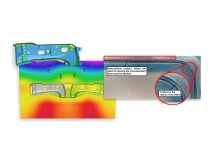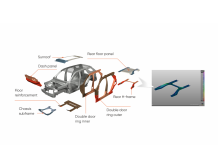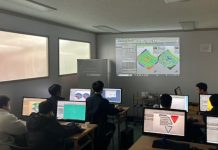It’s More than Just “Flattening” the Part
I[dropcap][/dropcap]n this post an AutoForm Application Engineer explains why you need to use AutoForm-Stamping-Adviser-FormCheck. A tool for early feasibility, it analyses the design process, allowing changes to be made before the geometries are set in stone. Later you can avoid getting stuck when changing tooling is the only option.
Stamping Adviser FormCheck is a product feasibility assessment tool within AutoForm, ideal for applying early on in product development. Based on the material properties, part geometry, and holding conditions, Stamping Adviser ‘FormCheck’ detects potential splitting and compression issues, evaluates material flow, and develops an unfolded blank geometry – all within a very short amount of time. Where a simulated part might take hours to run, it can be evaluated in a matter of five minutes or less using FormCheck.
Figure 1 shows when Stamping Adviser FormCheck is best applied.

Figure 1. Stamping Adviser FormCheck Production Stage Utilization
Let’s be clear, FormCheck does not provide depth of detail in simulation, as compared to other AutoForm products. So the question is, why run a five minute simulation? To answer that our experts demonstrated a side-by-side comparison of Stamping Adviser FormCheck and an Incremental simulation.

‘Being able to obtain quick results, and identify problematic geometries at an early phase means that part designers can modify the parts before its too late’ says Curtis Hsiung, AutoForm USA, adding ‘for such parts, developing them any further would be a waste of time. ‘FormCheck’ identifies 50% of all issues a full simulation would find. Secondly, later on you can only change the tooling which is quite limiting, as the geometries are set in stone.’
‘FormCheck results on the B-pillar (below) are very much comparable to the incremental simulation in terms of potential issues and issue locations. AutoForm FormCheck (depicted left) is able to use the part geometry along with an auto-generated boundary fill and addendum, and wrap surface, to identify problematic areas in just 1 minute compared to the 40 minutes, as typically required for setting up a simulation in Incremental.’

Figure 2 FormCheck and Incremental Simulation Comparison
Accordingly, there are two ways FormCheck can be applied:
- By only using part geometry, or:
- By automatically building a draw die, by adding surface extensions, addendum and binder to the part geometry (quick addendum)
‘With part geometry in FormCheck, one can locate the potential splits and compression on the part geometry and with the Quick Addendum, one can quickly estimate a blank size and shape and undergo cost analysis on top of the splits and wrinkle identification. The images below demonstrate both the Part Geometry FormCheck (left) and the Quick Addendum FormCheck (right). In both, the green shape below the geometries indicates the estimated blank shape. The Part Geometry FormCheck, though without an addendum, still gives a prediction on the blank shape based on the geometry, along with a draw-in prediction. On the other hand, the smoother boundary line that the quick addendum generated produced a more accurate blank shape and size prediction because it also accounts for the addendum.’

Figure 3. Part Geometry FormCheck vs Quick Addendum FormCheck
In the short seconds or minutes that FormCheck does calculations, the results of several holding conditions may be applied, allowing the user to examine part formability under different holding conditions. The “optimal” option is automatically identified as the one producing adequate stretch on the part. Figure 4 below shows the slider for holding condition and the “optimal” holding condition.

Figure 4. FormCheck Various Holding Condition Results
In addition to applying a uniform holding condition, AutoForm FormCheck allows the user to apply holding conditions in different segments and in different strengths, also known as “variable holding conditions” in AutoForm. This allows FormCheck to imititate a part with different bead strengths around the part or in some cases short-sheeting in certain locations. The FormCheck in Figure 5 was created by variable hold condition, imitating short-sheeting at all of the ends of the T-shaped b-pillar. Below is a comparison of the B-pillar part with and without variable holding conditions.

Figure 5. Uniform Holding Condition vs variable Holding Conditions
Curtis added ‘However, even with all the tools available to you in AutoForm, sometimes a potential split cannot be resolved without manufacturing considerations. Since Stamping Adviser FormCheck is used in the Early Feasibility Stages, and can be operated by part designers, geometry changes can be immediately applied and validated right away. To this end, AutoForm Stamping Adviser gives the user morph tools allowing one to try out modifications. Along with FormCheck, the user is able to see if specific part design changes will improve the formability of the part. Tools to morph, trim, extend, etc. the surfaces are all within the package of Stamping Adviser.’
Figure 6 shows a region with a small radius showing a potential split. By performing a radius change along the top surface, the potential split issue is neutralized in FormCheck.

Figure 6. Sharp Radius Along Top Surface vs Smooth Radius
‘The capability and flexibility of AutoForm Stamping Adviser along with FormCheck allows users of any knowledge level to perform early feasibility and formability checks on part designs as well as developing meaningful blank size estimates for early cost evaluations. It is exceptionally powerful in the hands of users with little die-knowledge, allowing them to observe and countermeasure geometries, in order to arrive at a part design that will be friendly for manufacturing.’ Curtis Hsiung.
Thank you for this interview Curtis. Interested in more? Read our earlier post related to this topic ‘Have you been burned my minimum blank quotes?’
New readers: if you haven’t signed up for our blog now is a good time to do so. You’ll never receive marketing emails from us – only pure blog updates, sent once per month concerning our top 4 posts.













